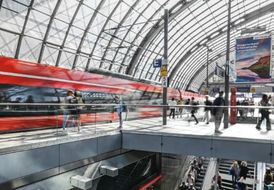Focus on digitalization projects and concepts
Artificial intelligence in rail operations
- For the Stuttgart, Rhine-Main and Munich S-Bahn (metro) trains, AI is already used to support the dispatchers in controlling traffic as efficiently as possible in the event of a disruption. DB Group has a positive balance sheet on the use of AI in rail operations: the use of the tool, developed in-house, has already prevented more than 58,000 minutes of delay in 2022. This means a significant improvement in the tightly timed S-Bahn (metro) network. Thanks to this development, despite the restrictions caused by construction work to modernize the lines, the S-Bahn (metro) is gaining stability. Due to the outstanding results from the Stuttgart pilot project, DB Group is now also using the technology for the S-Bahn (metro) in Frankfurt am Main and Munich. The AI processes the current operating situation by the second based on around 500 pieces of information per minute and generates its suggestions from this. Based on live operations, it continuously simulates the development of the traffic situation and reports potential conflicts early on. For the first time, this enables the dispatchers to intervene before a disruption occurs.
- In maintenance, we use AI to visually identify damage to ICEs. In future, this technology will be used in several ICE depots as well as on regional and freight trains.
Digital Rail for Germany
Digitalization, automation and artificial intelligence are the key to higher capacity and optimal utilization of the rail network. One of the targets of Digital Rail Germany (DSD) is a fully digital, highly automated rail system – from tracks to trains, from digital signaling stations through the European Train Control System (ETCS) to automatic train operation (ATO). In the future, the trains will be highly automated, able to recognize their environment and be located at a highly precise geographical location. Likewise, they should no longer run at fixed block distances, but instead in flexible blocks with optimal intervals between trains. In order to meet these requirements, the entire rail sector needs innovative thinking, design and implementation. Together with industry partners, associations and research institutes, the sector initiative Digital Rail Germany (DSD) is setting the course for the highly automated rail system of the future.
The implementation of the DSD initiative started in 2020. As part of the launch package, the concrete planning and installation of ETCS and digital interlockings has begun in the context of the Stuttgart Digital Hub (Digitaler Knoten Stuttgart; DKS), the Cologne — Rhine/Main high-speed line and the ability to traverse the Trans-European Scandinavia — Mediterranean corridor (ScanMed). Stuttgart will be the first region in Germany to receive the digital train control and interlocking technology. In order to support the corresponding refitting of vehicles, the BMDV has published a vehicle funding directive for the affected vehicles in the DKS, meaning that the vehicle equipment (regional and S-Bahn (metro) multiple units) could begin in 2022. In 2022, the first commissions also took place in the fast-track program (SLP). For example, on the Ruhr-Sieg line, the switching and signaling technology was completely renewed after just 1.5 years. The work on the fast-track program’s Cluster 2 projects and pre-series projects is progressing simultaneously. These projects are intended to create modern digital interlockings. To this end, comprehensive development services will also be performed with new market participants from the railway and technology sectors.
At the end of 2022, a first section of the line with ETCS Level 2 also went into operation successfully for the first time on the Rhine-Alpine corridor and in the highly overloaded existing network. The trains now run between Darmstadt Süd and Laudenbach (Bergstrasse) with state-of-the-art train control systems. The trackside approval procedure (TA procedure) was also approved by the European Union Railway Agency (ERA). With the approval, the equipment of ETCS Level 2 is confirmed to comply with the interoperability requirements in accordance with the Control Command and Signaling Technical Specification for Interoperability (TSI CCS). This is the first successfully completed TA procedure for an ETCS project by DB Netz AG and the first ERA ETCS level 2 approval in Europe. Lean processes and new standards essentially form the foundation for acceleration. As a result, valuable findings are collected for the DSD surface rollout. The chosen procedure is an important building block for the digitalization of the rail network within the DSD framework.
Digital interlocking technology continues to be tested at the “Digital Rail Test Site” in the Erzgebirge region, and the development of a 5G test network has become an important research environment, with eight 5G radio masts along the line. Following the realization of the Future Railway Mobile Communication System (FRMCS) test installations together with partners Nokia and Kontron and initial transfers were made possible, the practical testing of various innovative technologies relating to FRMCS/5G is in full swing. Together with DB Erzgebirgsbahn and partners Ericsson and Rohde&Schwarz, the world’s first field study of multi-
antenna radio technologies in the future FRMCS spectrum was conducted at 1.9 GHz. The investigation provided relevant findings in terms of connectivity between train and infrastructure and showed that innovative antenna systems can unlock the potential of FRMCS in terms of higher transmission rates and high reliability. In addition, existing buildings and their equipment are being expanded and modernized into a central laboratory.
The rollout schedule is currently being adjusted on the basis of clearly defined equipment priorities. An early increase in capacity is to be realized by prioritizing the equipment of closed transport systems, in particular in hubs; obsolescence and operational concerns should be taken into account and the equipment of basic infrastructure should be started in advance. The renovation of the high-performance networkµ 134 was also added to the DSD rollout plan in 2022. Digitalization of the rail network is a decisive and vital step in this direction. DSD is a major lever for advances in Germany’s transition to more sustainable mobility.
DB Group as part of Europe’s Rail
Europe’s Rail supports the European initiative on research, innovation and system integration in the railway sector. The partnership aims to strengthen the cost efficiency, integration and competitiveness of the rail sector in order to achieve the overall vision of a European rail system without system disruptions.
For example, work is being done to harmonize the system architecture and on the technical specifications for interoperability (TSI). Other key topics are the digitalization of freight transport with the digital automatic coupling (DAC), the digitalization of command and control technology and automatic train operation (ATO).
Digital maintenance
Digitalization and automation of maintenance will increase the availability of vehicles and systems.
- The digitalization of vehicle fleets for better condition monitoring is progressing. Digitalization has begun on around 800 vehicles from three series. In 2022, the first 140 vehicles were equipped with sensors to use condition data from the vehicles for condition-based maintenance and thus better asset productivity, availability and cost structures. By the end of 2024, all vehicles are to be converted and serve as a blueprint for further series.
- Digital fleet control is being implemented at DB Regional as a central element of digital vehicle maintenance. The rollout of the “dLox” application to aid train staff in technically recording damage to trains was also launched at DB Regional after successful use at DB Cargo. Since the end of 2022, dLox has been used productively in three regions. By mid-2023, a total of around 24,000 operating personnel at DB Cargo and DB Regional will use the application in their daily operations.
- Automation and digitalization in the depots are gaining momentum. By the end of 2023, the number of automated over-run measurement systems will grow to 15 systems. All DB Long-Distance depots and almost all S-Bahn (metro) trains at DB Regional will then have these modern facilities, which significantly reduces manual work and work hours.
- The E-Check project provides a camera-based partial automation of visual inspections for maintenance of the DB Long-Distance ICE fleet at five locations. In addition, two autonomous vehicles equipped with robots perform the supply of fresh water and the disposal of waste water. The first system will be built up in the first half of 2023. By the end of 2024, further systems will be gradually expanded in five facilities.
- The rollout of the iMate system, which was successfully introduced by DB Long-Distance for AI-based material recognition, was started in other business units. In the future, the application will be available to around 16,000 maintenance employees and will simplify the search for materials. By matching a photo with an image database, the correct component is identified quickly and safely.
- The wheel set workshop at the Kassel depot is being digitalized to improve delivery reliability. In 2022, digital feedback was introduced so that transparency about progress is available at all times in the production process, also enabling a delivery preview.
Digitalization of the vehicle fleet
We have launched the largest modernization program for our vehicle fleet to date. At the InnoTrans 2022 trade fair, we showcased numerous innovations, such as the DB Regional Ideas Train, the new ICE L, the digital automatic coupling for freight trains and the cargo two-engine locomotives. With digitalization and new technologies, we are solving the challenges of the future, bringing more trains to the rail network while at the same time being more punctual and reliable. In our test train, the advanced train lab, we showed how 180 years of railway know-how combines with the latest research.


